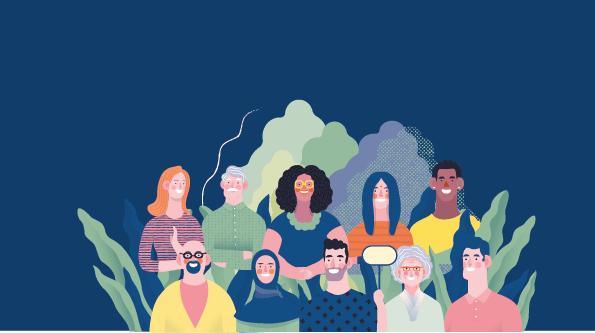Diversity in the workplace: why it matters and how to increase inclusion
Diversity in the workplace refers to the coexistence of individuals with varying characteristics, skills, and traits. It's crucial to pair diversity with inclusion, ensuring equal opportunities throughout the employee lifecycle. A diverse workforce brings unique perspectives, fostering creativity, innovation, and better product development.

We live in interesting times. The Black Lives Matter and #MeToo movements, the global rise of immigration, and large-scale political changes such as Brexit and the election of Trump, shed light on – previously overlooked – minority groups and draw our attention toward equal rights, racism, feminism and socio-economic disparities.
The workplace is not unaffected by all this. Calls for greater diversity in the workplace have increased exponentially. Now is the time for HR professionals to focus on diversity in the workplace and reinforcing inclusion not just in words, but in practice. Many are expecting to see results.
Contents
But what exactly is diversity in the workplace?
Diversity is the coexistence of people with different characteristics (e.g. race, age, gender, sexual orientation), skills and personality traits. For example, at work, we can talk about a diverse team when employees come from various cultural, academic and professional backgrounds and when there’s a balance in gender, age and race. You can find more examples in our diversity in the workplace definition.
You can’t build diverse teams, though, without pairing diversity with inclusion. Nor have you “won” if you now have a diverse team, because equity and inclusion are where the real work begins. Employees feel included in their workplace when they have equal opportunities during the entire employee lifecycle: from the way they’re treated during the hiring process to how they’re being managed, trained, evaluated and promoted.
But this can’t happen automatically. To build an inclusive workplace, employers must provide those equal opportunities to all potential and existing employees. They should also revisit and improve their procedures as needed to ensure they’re respectful to all people regardless of protected characteristics.
For an inclusive workplace, employers must provide equal opportunities to all potential & existing employees. They should also improve procedures as needed to ensure they’re respectful to all regardless of protected characteristics.
The importance of diversity and inclusion
Why do we care so much about DEI in the workplace, though? And why should we care? Is it simply the right thing to do or are there business gains associated with diversity?
It’s both. When you try to build diverse teams, you fight discrimination in the workplace. You aim to give equal opportunities to all employees – even those (or especially those) in underrepresented groups.
We can better understand the value of diversity in the workplace with some examples of what happens when companies don’t take into account diverse voices. Two diversity in the workplace articles talk about the importance of a diverse workforce when building and testing products:
- a Black person struggles to use an automatic soap dispenser because the light sensor doesn’t detect a dark-skinned hand
- Black women speak up about the extensive hair searches they have to undertake at airports, as body scanners give false alarms due to their natural Afro.
These examples prove that diversity, equity and inclusion is not just about the moral aspect of it; when you add diverse voices in your teams, you learn things you wouldn’t have known otherwise, you build better products and you increase equity in the workplace and beyond.
There are financial benefits, too, that motivate employers to boost their DEI efforts. Diverse companies:
- Reflect societies more accurately. Societies are by default diverse in age, race, gender and socio-economic class. Therefore, organizations with diverse employees are better aligned with the demographics of the area (or areas) where they operate. On a macroeconomics scope, this means that they can better predict – and adjust to – changes in the market and local consumer behavior.
- Speak to a broader audience. People usually relate to those from a similar background. So, when your employees come from various backgrounds, they can understand the needs, interests and pain points of diverse audiences, too. This gives you the opportunity to expand your messaging and promote your products and services to a larger customer base.
- Get more creative and profitable. Diversity doesn’t only refer to protected characteristics. There’s also diversity of thought – that may or may not be a result of different protected characteristics. Employees with different experiences and perspectives can bring fresh ideas and innovative solutions to the table which, in turn, benefit the entire organization.
You can start building a business case for diverse teams for your organization with studies and interesting stats.
Diversity, Equity & Inclusion in action
A quick online search will give you lots of studies and articles on the benefits of diversity in the workplace. And while talking about diversity is a good thing, because it means we’re paying attention, it’s not enough. Let’s take a deeper look at how companies, and particularly HR departments, can actively foster diversity in the workplace.
The legal aspect of diversity in the workplace
To promote diversity at work, there is legislation that protects minority or underrepresented groups from discrimination. There are also regulations that reinforce human rights in the workplace. For example, in many countries, employers can’t fire a pregnant employee and they can’t include age and gender requirements in their job ads unless it’s absolutely necessary or relevant for the role. It’s best to consult a lawyer to ensure that your company complies with all relevant legislation that applies in your specific location.
In the United States, Equal Employment Opportunity Commission (EEOC) is the regulatory body that enforces diversity in every work situation; for example, when employers hire, terminate, compensate, promote, and train employees. For more details, check our guides and learn what you need to do to comply with the law:
- What is Equal Employment Opportunity (EEO)
- EEO guidelines for employers
- How to follow EEOC regulations
- How to file an EEO-1 report
- Why EEO statements fall short
In Canada, the Human Rights Act includes a number of laws and regulations that protect people against discriminatory practices. There are also specific regulations about equal pay and the Canadian Human Rights Commission where employees can file complaints when treated unfairly.
The UK has established a similar commission, the Equality and Human Rights Commission, that provides guidance for employees and employers regarding the Equality Act 2010.
Finally, the European Union has implemented a series of non-discriminatory directives to reinforce equity across the EU. For example, the Directive 2000/78/EC is about discrimination at work on grounds of religion or belief, disability, age or sexual orientation and the Directive 2006/54/EC provides the framework of equal treatment for men and women in matters of employment and occupation.
Anti-discrimination laws are not here to pose limitations to employers. They exist so that all people have equal opportunities at work. It’s important to have an official, legal context that ensures that companies treat employees objectively and respectfully, because we are all prone to unconscious bias. Also, sometimes for the sake of faster hiring, it’s common to pick candidates based on convenience, i.e. based on arbitrary or even superficial hiring criteria.
In this case, diversity regulations can serve as guidelines for employers who don’t just need or want to be compliant with the law, but try to actively fight all types of discrimination in the workplace. For example, take a look at these illegal interview questions – even if it’s not legally forbidden to ask them in your area, it’s still a good idea to avoid them so that you hire candidates using objective, job-related criteria.
The role of recruiters and HR
While increasing DEI is not one person’s (or one department’s) responsibility, the HR experts can take many actions to build a truly inclusive workplace. That’s because they’re in charge of everything that has to do with the human aspect of the company: from attracting and recruiting diverse candidates to setting the guidelines for fair treatment, management and compensation of all employees to ensure a fully inclusive workplace.
Here’s how recruiters and HR professionals can foster workplace diversity:
- Remove biases from hiring. From gender-neutral job descriptions to targeted, skill-based interview questions, your hiring process should be built in a way that helps you find the best people for the job – not the ones you like the most. Here are some examples from companies that are taking actions to reduce bias in recruiting, plus a few tips to get you started when you aim to create an inclusive work environment.
- Look for areas of improvement. Diversity might not always be tangible, but you can still set some goals and track your progress. For example, what’s the gender ratio at your company and by department? How many of your female employees have a leadership role? If those numbers are not close to your goals, you might want to invest your energy into increasing diversity specifically in these areas. Rachel Bates, who was SVP of Sales & Marketing at Workable until spring 2020, describes how she successfully built a more gender-balanced sales team, while recruitment expert Matt Buckland, at one point Workable’s VP of Customer Advocacy, advises on how to hire more women in tech, a traditionally male-dominated field.
- Consider the overlooked types of diversity. When we talk about diversity, we mostly refer to race and gender. But there’s more than that. Some examples include age discrimination, bias against employees with disabilities, and rejection of candidates with non-traditional career paths. You should also keep in mind that there’s intersectionality in the workplace, i.e. overlapping biases such as age and gender discrimination. Your DEI efforts should take into account all different types of diversity that exist in your workplace – or that you’d like them to exist.
- Involve all of your team members. A recruiter alone can’t build a diverse company. Picture this: As a recruiter at your company, you might be diversifying your candidate sources and screening resumes with strictly job-related criteria. But if those who’re making the final hiring decision are biased, they could still reject good candidates because, for example, some candidates don’t have a degree from a prestigious school. It’s essential that all employees, no matter their seniority level, understand the importance of diversity in the workplace. Whether it’s through bias trainings or official anti-discrimination company policies, everyone should be aware of expectations, values and appropriate behaviors in terms of mutual respect and acceptance. For example, those who’re involved in recruiting should know how to document interview feedback to help their teams make well-rounded hiring decisions and all colleagues should know what constitutes unacceptable work behavior.
Why oppose diversity in the workplace?
“I want to hire people I get along with because I know we’ll collaborate better.”
“When I’m actively looking to increase the number of female employees at my company, don’t I discriminate against male candidates?”
“Things like religious beliefs and sexual preferences have no place in a professional setting – they only bring controversy and distractions from work.”
These are valid concerns, but not strong enough to dismiss DEI efforts from the workplace. In fact, it’s quite the opposite; it goes back to building an inclusive environment where all employees feel safe and respected no matter their protected characteristics, personal opinions, backgrounds, etc.
You fight the challenges of diversity in the workplace by structuring your interview process in a way that helps you hire on merit (rather than make decisions that lead to homogenous teams) by implementing affirmative action programs to support underrepresented groups when needed, and by setting the framework for approaching controversial topics at work.
Ultimately, you want to create a place where employees are treated equally and there are no privileged and underprivileged groups, and everyone feels included.
Frequently asked questions
- Why are diversity and inclusion important in the workplace?
- Diversity in the workplace refers to the presence of individuals with varying characteristics such as race, age, gender, and sexual orientation. It also includes diversity in skills and personality traits. A diverse workplace is one where there's a balance in gender, age, and race, and employees come from various cultural, academic, and professional backgrounds.
- How can you add diversity inclusion in the workplace?
- Pairing diversity with inclusion is essential because diversity alone doesn't guarantee an equitable workplace. Employees feel included when they have equal opportunities throughout their employment lifecycle, from the hiring process to management, training, evaluation, and promotion.
- What are the benefits of having diversity in the workplace?
- Diversity and inclusion in the workplace offer several benefits. They fight discrimination, provide equal opportunities to all employees, and bring diverse voices into teams, leading to better products and increased equity. Diverse companies reflect societies more accurately, speak to a broader audience, and are more creative and profitable due to the diversity of thought.
- What role do recruiters and HR professionals play in fostering workplace diversity?
- Recruiters and HR professionals play a significant role in fostering workplace diversity. They can remove biases from hiring, look for areas of improvement, consider overlooked types of diversity, and involve all team members in the process.
- Why might some people oppose diversity in the workplace?
- Some people might oppose diversity in the workplace due to concerns about collaboration, potential discrimination against non-underrepresented groups, or the introduction of controversial topics. However, these concerns are not strong enough to dismiss diversity, equity, and inclusion efforts.




